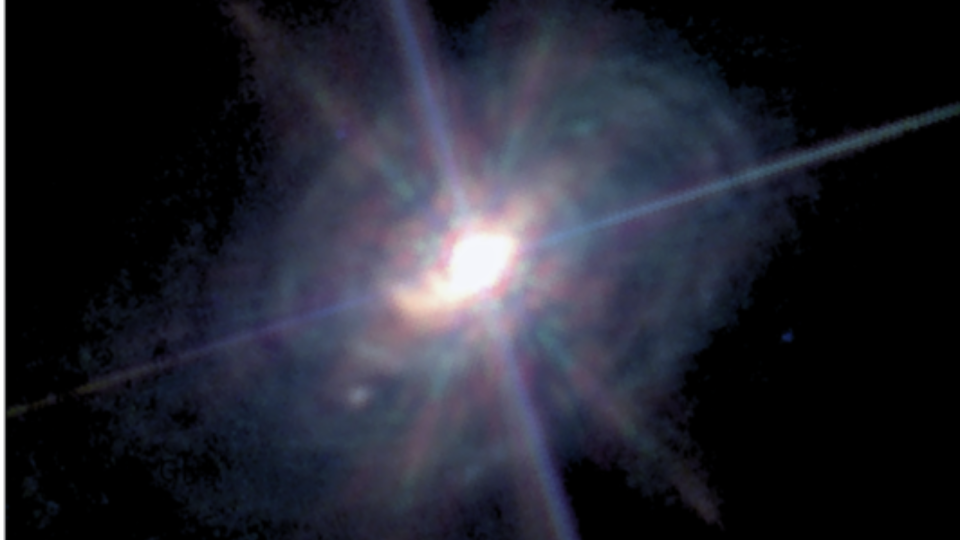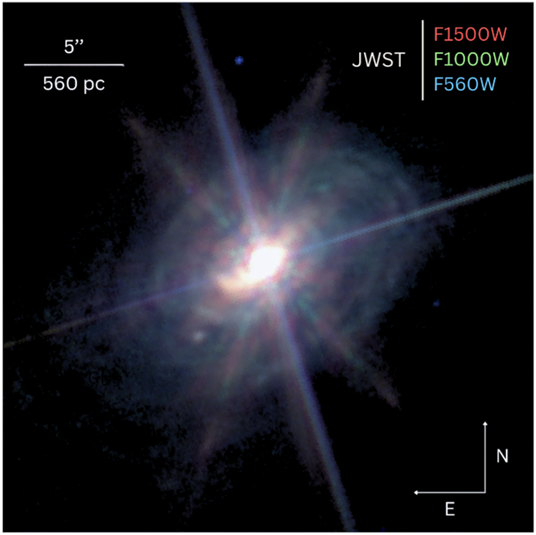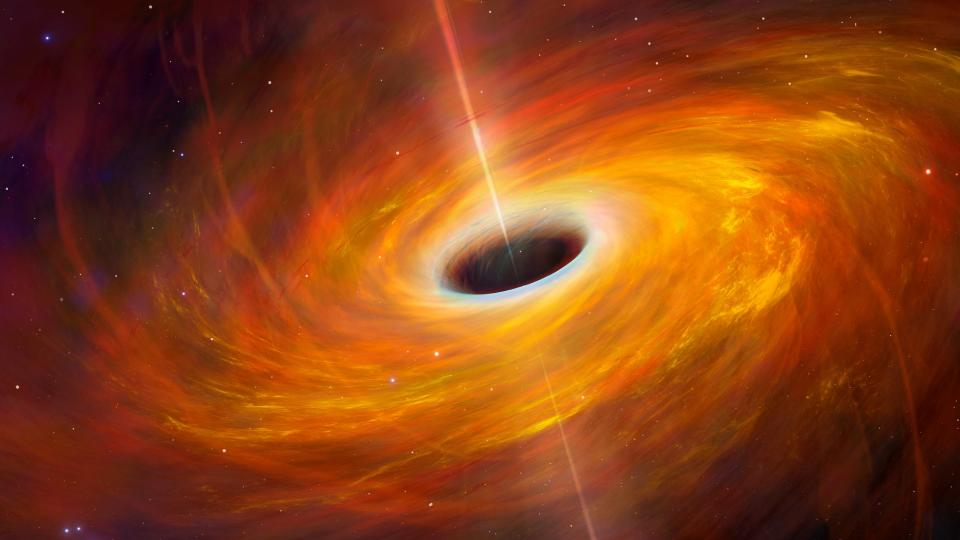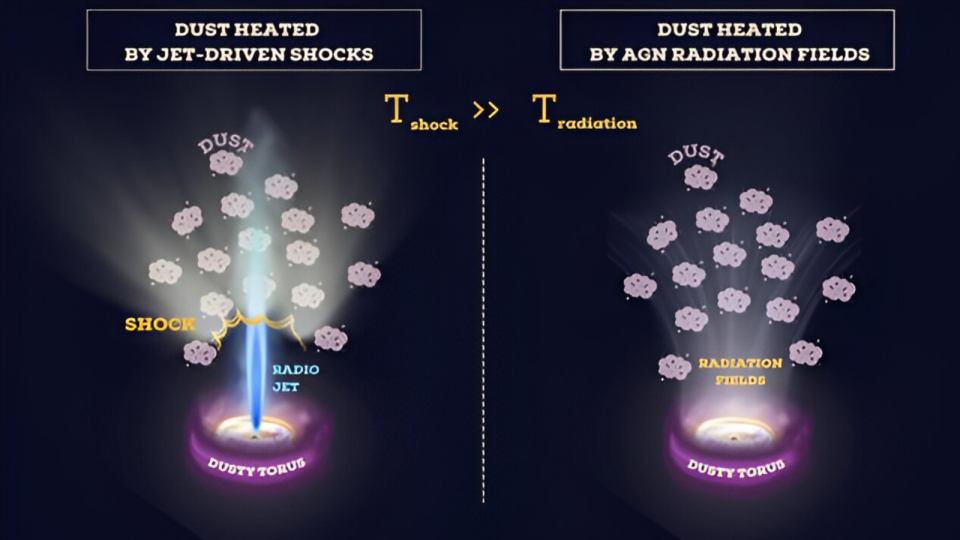When you buy through links in our articles, Future and its syndication partners may earn a commission.

Using the James Webb Space Telescope (JWST), astronomers have imaged the structure of dust and gas around a distant supermassive black hole. They have literally discovered a ‘shock structure’.
The team discovered that the energy heating up this swirling cloud of gas and dust actually comes from collisions with jets of gas traveling at nearly the speed of light, known as “shocks.” Scientists had previously suggested that the energy heating up this dust came from the supermassive black hole itself, making this an unexpected twist.
The galactic home of this particular supermassive black hole is ESO 428-G14, an active galaxy located about 70 million light-years away from Earth. The term “active galaxy” means that ESO 428-G14 has a central region or “active galactic nucleus” (AGN) that emits powerful and intense light across the electromagnetic spectrum due to the presence of a supermassive black hole voraciously feeding on matter around it.
The shocking AGN finding was made by members of the Galactic Activity, Torus, and Outflow Survey (GATOS) collaboration, which uses special JWST observations to study the hearts of nearby galaxies.
“There is a lot of debate about how AGN transfer energy to their surroundings,” GATOS team member David Rosario, a Senior Lecturer at the University of Newcastle, said in a statement. “We didn’t expect radio jets to cause this kind of damage. And yet here it is!”
Related: Dark matter could be a ‘coupler’ for supermassive black holes


Unraveling the secrets of a ‘noisy’ black hole
All large galaxies are thought to have central supermassive black holes, with masses ranging from millions to billions of times that of the Sun. But not all of these black holes are in AGNs.
Take the Milky Way, for example. The supermassive black hole Sagittarius A* (Sgr A*) in our galaxy is surrounded by so little material that its “diet” of matter is equivalent to a human living on one grain of rice per million years. This makes Sgr A*, which has a mass equal to about 4.3 million suns, a “quiet” black hole, but it certainly has some noisy neighbors.
Take the supermassive black hole at the heart of the galaxy Messier 87 (M87), which is located about 55 million light-years away. This black hole M87* is not only much more massive than Sgr A*, with a mass equal to about 6.5 billion suns, but it is also surrounded by a large amount of gas and dust, which it feeds on.
This matter can’t just fall directly onto M87* because it has angular momentum. This means it forms a spinning, flattened cloud of gas and dust around the supermassive black hole, called an “accretion disk,” which it gradually feeds.


Supermassive black holes don’t sit passively in accretion disks waiting to be fed, like a cosmic baby in a high chair. The immense gravity of these cosmic titans generates enormous tidal forces in the accretion disk, creating a fiction that heats it to temperatures as high as 18 million degrees Fahrenheit (10 million degrees Celsius).
This causes the accretion disk to glow brightly, which powers some of the AGN’s illumination. The immense gravitational influence of these cosmic titans generates enormous tidal forces in the accretion disk, creating a fiction that heats the disk to temperatures as high as 18 million degrees Fahrenheit (10 million degrees Celsius).
But that’s not all.
Like an unruly toddler, not all of a supermassive black hole’s “food” goes into its “mouth.” Powerful magnetic fields funnel some of the matter in accretion disks toward the black hole’s poles, accelerating these charged particles to near the speed of light. Just like your child throwing his food at you.
From the two poles of the black hole, this matter bursts outward as parallel astrophysical jets. These jets are also accompanied by the emission of light across the electromagnetic spectrum, particularly powerful in radio waves.
As a result of these contributions, AGNs can be so bright that they outshine the combined light of all the stars in the surrounding galaxy.


The dust surrounding AGNs can often block our view of their hearts by absorbing visible light and other wavelengths of electromagnetic radiation. Infrared light, however, can slip through this dust, and conveniently enough, the JWST sees the cosmos in infrared. That means the powerful space telescope is the perfect tool for peering into the centers of AGNs.
When the GATO team did this for ESO 428-G14, they found that dust near the supermassive black hole spreads out along its jet. This revealed an unexpected relationship between the jets and the dust, suggesting that these powerful outflows could be responsible for both heating and creating the dust.
Related Stories:
— Colliding black holes ‘orbit’ through space-time with gravitational wave ripples
—Colliding black holes could be hiding in the light of super-bright quasars
— 2 Merging Supermassive Black Holes Discovered at ‘Cosmic Noon’ in Early Universe
By further investigating the connection between jets and dust around supermassive black holes, we could gain insight into the impact these cosmic titans have on the shaping of their galaxies and how material is recycled into AGNs.
“Having the opportunity to work with exclusive JWST data and access these stunning images before anyone else is beyond exciting,” said Houda Haidar, a PhD student in Newcastle University’s School of Mathematics, Statistics and Physics. “I feel incredibly lucky to be part of the GATOS team. Working closely with leading experts in the field is truly a privilege.”
The team’s research was published in the journal Monthly Notices of the Royal Astronomical Society.